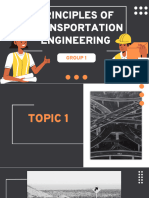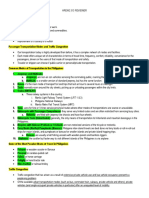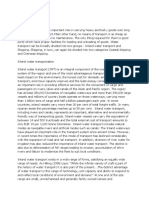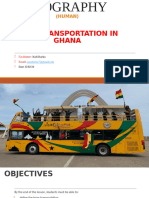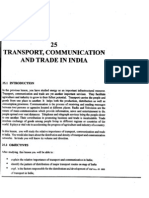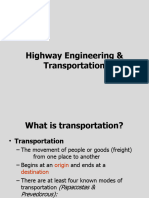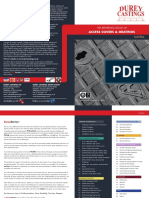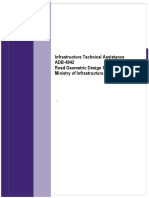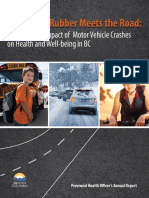0 ratings0% found this document useful (0 votes)
6 viewsWorld Transport
World Transport
Uploaded by
Anitha AnyamCopyright:
© All Rights Reserved
Available Formats
Download as PPTX, PDF, TXT or read online from Scribd
World Transport
World Transport
Uploaded by
Anitha Anyam0 ratings0% found this document useful (0 votes)
6 views37 pagesOriginal Title
World Transport (1)
Copyright
© © All Rights Reserved
Available Formats
PPTX, PDF, TXT or read online from Scribd
Share this document
Did you find this document useful?
Is this content inappropriate?
Copyright:
© All Rights Reserved
Available Formats
Download as PPTX, PDF, TXT or read online from Scribd
Download as pptx, pdf, or txt
0 ratings0% found this document useful (0 votes)
6 views37 pagesWorld Transport
World Transport
Uploaded by
Anitha AnyamCopyright:
© All Rights Reserved
Available Formats
Download as PPTX, PDF, TXT or read online from Scribd
Download as pptx, pdf, or txt
You are on page 1of 37
World transport
• Natural resources, economic activities and
markets are rarely found in one place. Transport,
communication and trade establish links between
producing centres and consuming centres.
• The system of mass production and exchange is
complex. Each region produces the items for
which it is best suited. Trade or the exchange of
such commodities relies on transportation and
communication
Transportation
• Likewise, the high living standards and quality
of life depend on efficient transportation,
communications and trade.
• In earlier days, the means of transport and
communication were the same. But today
both have acquired distinct and specialised
forms.
• Transport provides the network of links and
carriers through which trade takes place.
TRANSPORT
• Transport is a service or facility for the carriage of
persons and goods from one place to the other
using humans, animals and different kinds of
vehicles.
• Such movements take place over land, water and
air.
• Roads and railways form part of land transport;
while shipping and waterways and airways are the
other two modes. Pipelines carry materials like
petroleum, natural gas, and ores in liquidified form.
Importance of transportation
• Moreover, transportation is an organised service
industry created to satisfy the basic needs of
society. It includes transport arteries, vehicles to
carry people and goods, and the organisation to
maintain arteries, and to handle loading, unloading
and delivery. Every nation has developed various
kinds of transportation for defence purposes.
Assured and speedy transportation, along with
efficient communication, promote cooperation and
unity among scattered peoples.
MODES OF TRANSPORTATION
• The principal modes of world transportation,
as already mentioned are land, water, air and
pipelines.
• These are used for inter-regional and intra-
regional transport, and each one (except
pipelines) carries both passengers and freight.
• The significance of a mode depends on the
type of goods and services to be transported,
costs of transport and the mode available.
MODES OF TRANSPORTATION
• International movement of goods is handled
by ocean freighters. Road transport is cheaper
and faster over short distances and for door-to
door services. Railways are most suited for
large volumes of bulky materials over long
distances within a country. High-value, light
and perishable goods are best moved by
airways. In a well-managed transport system,
these various modes complement each other.
Land Transport
Land Transport
• Most of the movement of goods and services
takes place over land. In early days, humans
themselves were carriers.
• bride being carried on a palanquin (palki/doli)
by four persons (Kahars in north India). Later
animals were used as beasts of burden
Land transport evolution
• With the invention of the wheel, the use of carts
and wagons became important. The revolution in
transport came about only after the invention of
the steam engine in the eighteenth century.
Perhaps the first public railway line was opened
in 1825 between Stockton and Darlington in
northern England and then onwards, railways
became the most popular and fastest form of
transport in the nineteenth century.
Evolution of land transport
• It opened up continental interiors for commercial grain
farming, mining and manufacturing in U.S.A. The
invention of the internal combustion engine
revolutionised road transport in terms of road quality
and vehicles (motor cars and trucks) plying over them.
• Among the newer developments in land transportation
are pipelines, ropeways and cableways. Liquids like
mineral oil, water, sludge and sewers are transported
by pipelines. The great freight carriers are the railways,
ocean vessels, barges, boats and motor trucks and
pipelines
• In general, the old and elementary forms like the
human porter, pack animal, cart or wagon are the
most expensive means of transportation and large
freighters are the cheapest.
• They are important in supplementing modern
channels and carriers which penetrate the interiors
in large countries. In the densely populated districts
of India and China, overland transport still takes
place by human porters or carts drawn or pushed
by humans.
Roads
Roads
• Road transport is the most economical for short
distances compared to railways. Freight transport
by road is gaining importance because it offers
door-to-door service.
• But unmetalled roads, though simple in
construction, are not effective and serviceable for
all seasons.
• During the rainy season these become unmotorable
and even the metalled ones are seriously
handicapped during heavy rains and floods.
Roads
• In such conditions, the high embankment of
rail-tracks and the efficient maintenance of
railway transport service, is an effective
solution.
• But the rail kilometrage being small cannot
serve the needs of vast and developing
countries at a low cost. Roads, therefore, play
a vital role in a nation’s trade and commerce
and for promoting tourism.
Roads
• The quality of the roads varies greatly
between developed and developing countries
because road construction and maintenance
require heavy expenditure. In developed
countries good quality roads are universal and
provide long-distance links in the form of
motorways, autobahns (Germany), and inter–
state highways for speedy movement
Autobahns of germany
• Lorries, of increasing size and power to carry
heavy loads, are common. But unfortunately,
the world’s road system is not well developed.
Heavy trucks
Trucks of USA
Trucks of india
E- highway of germany
ROAD DENSITY
• The world’s total motorable road length is only
about 15 million km, of which North America
accounts for 33 per cent. The highest road
density and the highest number of vehicles
are registered in this continent compared to
Western Europe.
TRAFFIC FLOWS
• Traffic on roads has increased dramatically in
recent years. When the road network cannot cope
with the demands of traffic, congestion occurs. City
roads suffer from chronic traffic congestion. Peaks
(high points) and troughs (low points) of traffic
flow can be seen on roads at particular times of
the day, for example, peaks occurring during the
rush hour before and after work. Most of the cities
in the world have been facing the problem of
congestion
TRAFFIC JAMS IN CHINA
Road net work in North America
• In North America, highway density is high, about 0.65
km per sq km. Every place is within 20 km distance from
a highway.
• Cities located on the Pacific coast (west) are well-
connected with those of the Atlantic Coast (east).
Likewise, the cities of Canada in the north are linked
with those of Mexico in the south.
• The Trans Canadian Highway links Vancouver in British
Columbia(west coast) to St. John’s City in Newfoundland
(east coast) and the Alaskan Highway links Edmonton
(Canada) to Anchorage (Alaska)
Trans canadian highway
Trans Canadian highway
Pan american highway
• The Pan-American Highway, a large portion of
which has been constructed, will connect the
countries of South America, Central America
and U.S.A.-Canada.
Pan american highway
Australia
• The TransContinental Stuart Highway connects
Darwin (north coast) and Melbourne via
Tennant Creek and Alice Springs in Australia.
Australia
Europe
• Europe has a large number of vehicles and a
well-developed highway network. But
highways face a lot of competition from
railways and waterways.
Russia
• In Russia, a dense highway network is
developed in the industrialised region west of
the Urals with Moscow as the hub. The
important Moscow-Vladivostok Highway
serves the region to the east. Due to the vast
geographical area, highways in Russia are not
as important as railways.
China
• In China, highways criss-cross the country
connecting all major cities such as Tsungtso
(near Vietnam boundary), Shanghai (central
China), Guangzhou (south) and Beijing (north).
A new highway links Chengdu with Lhasa in
Tibet
You might also like
- Claas Jaguar 980 - 970 960 950 940 930 (Type 497) - Operator's ManualDocument14 pagesClaas Jaguar 980 - 970 960 950 940 930 (Type 497) - Operator's ManualManuals CatalogsNo ratings yet
- Chapter 8 Transport and Communication Class 12 Geography NotesDocument13 pagesChapter 8 Transport and Communication Class 12 Geography NotesNaman GargNo ratings yet
- Transport and CommunicationDocument10 pagesTransport and Communicationbestgamer9201No ratings yet
- Ch-8 Transport and CommunicationDocument27 pagesCh-8 Transport and CommunicationPratik YadavNo ratings yet
- B1-7 Transport and CommunicationDocument38 pagesB1-7 Transport and CommunicationBhushanNo ratings yet
- Chapter Transport Human GeographyDocument8 pagesChapter Transport Human Geographyer.pranjalmehra26No ratings yet
- Transport and Communication: Unit-IIIDocument16 pagesTransport and Communication: Unit-IIIRouful RasoolNo ratings yet
- "Transportation": A Presentation ONDocument13 pages"Transportation": A Presentation ONcome2pratikNo ratings yet
- Open PMFIAS-Geo-HG-07-Transport-Communication - PDF 3Document55 pagesOpen PMFIAS-Geo-HG-07-Transport-Communication - PDF 3utkarshp.singh786No ratings yet
- Group 1Document38 pagesGroup 1Arianne Rose MamelocoNo ratings yet
- Introduction To Highway Engineering: 1. Importance of TransportationDocument7 pagesIntroduction To Highway Engineering: 1. Importance of TransportationFrancis AguisandaNo ratings yet
- MR Mahmoud PresentationDocument7 pagesMR Mahmoud PresentationGailanNo ratings yet
- Transportation ModesDocument39 pagesTransportation ModesChristine Anne PintacNo ratings yet
- Rema 101Document25 pagesRema 101Cyril Jean GulmaticoNo ratings yet
- Transportation and CommunicationDocument30 pagesTransportation and CommunicationPiyush SinghNo ratings yet
- Chapter 6 - Staying ConnectedDocument36 pagesChapter 6 - Staying Connectedvenkat.raghu2012No ratings yet
- Introduction To Highway EngineeringDocument62 pagesIntroduction To Highway Engineeringjessa aranes100% (1)
- TranspDocument11 pagesTranspSree HarshaNo ratings yet
- Social SciencesDocument12 pagesSocial Sciencessmhj6h4z6tNo ratings yet
- Transport and CommunicationkeDocument11 pagesTransport and Communicationkeaaronnjugi412No ratings yet
- Report in TranspoDocument10 pagesReport in TranspoRamces SolimanNo ratings yet
- Introduction To The SeminarDocument17 pagesIntroduction To The SeminarAditya BhandareNo ratings yet
- Group 1-TranspoDocument11 pagesGroup 1-TranspoHals MataNo ratings yet
- Transport or Transportation Is The Movement of People, Animals andDocument14 pagesTransport or Transportation Is The Movement of People, Animals andHarleen KaurNo ratings yet
- 2 Components of The Transportation SystemDocument41 pages2 Components of The Transportation SystemJoshua Melegrito PeraltaNo ratings yet
- CH 8 Transport and CommunicationDocument31 pagesCH 8 Transport and Communicationshubhramavat1322No ratings yet
- Transportation Lesson 3Document14 pagesTransportation Lesson 3Ana Judea DanaoNo ratings yet
- Lifelines of Indian EconomyDocument61 pagesLifelines of Indian EconomyADRIAN TAT0% (1)
- CH 7 Human Environment Settlement Transport Communication 2Document15 pagesCH 7 Human Environment Settlement Transport Communication 2Naitik KhuranaNo ratings yet
- Hreng 313 Reviewer TermsDocument12 pagesHreng 313 Reviewer TermsErika TolentinoNo ratings yet
- Transportation NotesDocument1 pageTransportation NotesNirvaan SinghalNo ratings yet
- 7 - Transport & CommunicationDocument21 pages7 - Transport & Communicationtobit6182No ratings yet
- Chapter 1 Introduction To 1Document5 pagesChapter 1 Introduction To 1beryl tchakounteNo ratings yet
- Water TransportDocument4 pagesWater Transport福发No ratings yet
- TransportationDocument85 pagesTransportationdorcasboadi116No ratings yet
- TRANSPORTATIONDocument7 pagesTRANSPORTATIONramlochanchristine3No ratings yet
- TPC 5 Transportation Management - HandoutDocument8 pagesTPC 5 Transportation Management - HandoutKarenNo ratings yet
- Geography term4Document18 pagesGeography term4lewele0105No ratings yet
- Key notes Lifelines of the National Economy 2Document12 pagesKey notes Lifelines of the National Economy 2Vivita DsouzaNo ratings yet
- Transport:: Need For TransportationDocument28 pagesTransport:: Need For Transportationraashi bakshiNo ratings yet
- G7 Lifeline of National Economy 3Document33 pagesG7 Lifeline of National Economy 3mdyusuff2124No ratings yet
- L-25 Transport Communication and Trade in IndiaDocument24 pagesL-25 Transport Communication and Trade in IndiaMeghana ReddyNo ratings yet
- Transportation (My Story Telling)Document3 pagesTransportation (My Story Telling)JIhan PermataNo ratings yet
- Chapter 1_CSEN 312_Transportation Engineering.docx - CopyDocument4 pagesChapter 1_CSEN 312_Transportation Engineering.docx - Copymosetilameck75No ratings yet
- Introduction To Highway and Railroad EngineeringDocument15 pagesIntroduction To Highway and Railroad EngineeringRegilyn CutarNo ratings yet
- Freight Technical, Operational and Commercial CharacteristicsDocument2 pagesFreight Technical, Operational and Commercial CharacteristicsMetchie Rico RafaelNo ratings yet
- Ce302: Highway and Railroad Engineering: By: Rolls Grant Vasquez, CeDocument22 pagesCe302: Highway and Railroad Engineering: By: Rolls Grant Vasquez, CeTyrone PaulinoNo ratings yet
- Pavement Engineering Lec-1Document16 pagesPavement Engineering Lec-1Aqib HussainNo ratings yet
- ETE 311 2023 Lecture 1 SlidesDocument10 pagesETE 311 2023 Lecture 1 SlidesTapiwa MabhandiNo ratings yet
- Cbse Class 10 Social Science Geography Chapter 7 NotesDocument10 pagesCbse Class 10 Social Science Geography Chapter 7 Notespanigrahipinki6No ratings yet
- 12 Transport and Communication Q&ADocument5 pages12 Transport and Communication Q&ARohiniNo ratings yet
- 1.3. Introductio N To Transportation EngineeringDocument46 pages1.3. Introductio N To Transportation EngineeringDindo YapyapanNo ratings yet
- Introduction To Transportation Planning and Engineering: Components of Transportation SystemDocument22 pagesIntroduction To Transportation Planning and Engineering: Components of Transportation SystemJudd Cortez100% (1)
- Referat Transport EnglezaDocument6 pagesReferat Transport EnglezawithusernameNo ratings yet
- Guided By: Prof. Seema Vyas: Presented By: Divya AgarwalDocument39 pagesGuided By: Prof. Seema Vyas: Presented By: Divya AgarwalDivya AgarwalNo ratings yet
- Identify and Discuss The Differences Between Inland Transportation and Land TransportationDocument13 pagesIdentify and Discuss The Differences Between Inland Transportation and Land Transportation福发100% (1)
- GeographyDocument5 pagesGeographynatiknagar2008No ratings yet
- Transportation Engineereing Lect AssigDocument7 pagesTransportation Engineereing Lect Assigkiran khanNo ratings yet
- Land Transportation Lesson 3Document23 pagesLand Transportation Lesson 3Akira PajulasNo ratings yet
- Comapritive Study of Air India and Indi GoDocument66 pagesComapritive Study of Air India and Indi GoJunaid KhanNo ratings yet
- The Iron Road: An Illustrated History of the RailroadFrom EverandThe Iron Road: An Illustrated History of the RailroadRating: 3.5 out of 5 stars3.5/5 (9)
- Cemex Holdings Philippines Annual Report 2016 PDFDocument47 pagesCemex Holdings Philippines Annual Report 2016 PDFFritz NatividadNo ratings yet
- Ce8703 Structural Design and Drawing MCQDocument28 pagesCe8703 Structural Design and Drawing MCQThangavel DNo ratings yet
- Addishiwot TadesseDocument135 pagesAddishiwot TadessebelshaNo ratings yet
- Durey CastingsDocument28 pagesDurey CastingsAdrian BuicaNo ratings yet
- NS012723 - PRDP FMR in Sampaloc-EditedDocument4 pagesNS012723 - PRDP FMR in Sampaloc-EditedRadel LlagasNo ratings yet
- Q A Traffic ManagementDocument26 pagesQ A Traffic ManagementChester Cuarentas100% (1)
- Typical Road Structure Cross Section DetailsDocument4 pagesTypical Road Structure Cross Section DetailsDipankar OkayNo ratings yet
- 4 Urbanization JournalofEnvironmentandNaturalScienceDocument11 pages4 Urbanization JournalofEnvironmentandNaturalScienceস্ব জলNo ratings yet
- Lifelines of National Economy Important QuestionsDocument12 pagesLifelines of National Economy Important QuestionsRiyaNo ratings yet
- CESMM4.pdf MeasurementDocument43 pagesCESMM4.pdf MeasurementEmmanuel NamkumbeNo ratings yet
- Development of Bundelkhand Expressway Pro Ject: 30 Days Industrial Training atDocument98 pagesDevelopment of Bundelkhand Expressway Pro Ject: 30 Days Industrial Training atAditya KumarNo ratings yet
- 6 Civil - Engg 6 Level 076-2-12 FinalDocument7 pages6 Civil - Engg 6 Level 076-2-12 FinalParas NiraulaNo ratings yet
- QAP For Road WorksDocument25 pagesQAP For Road Workspiyushiit100% (1)
- Traffic Impact Models: by Sia Ardekani Ezra Hauer Bahram JameiDocument26 pagesTraffic Impact Models: by Sia Ardekani Ezra Hauer Bahram JameiAhmed AbdulshafiNo ratings yet
- Kazys Petkevicius Julius Christauska PDFDocument6 pagesKazys Petkevicius Julius Christauska PDFJulio Andrés Casal RamosNo ratings yet
- FORS Vehicle Safety Equipment Guide v6Document22 pagesFORS Vehicle Safety Equipment Guide v6Wali ul IslamNo ratings yet
- CitiesDocument19 pagesCitiesvalik.play.gameNo ratings yet
- Fieldwork Risk Assessment (Low Risk Activities) Fieldwork Project DetailsDocument3 pagesFieldwork Risk Assessment (Low Risk Activities) Fieldwork Project DetailsDiyoke HenryNo ratings yet
- Schedule HDocument10 pagesSchedule HABPL INFONo ratings yet
- Historical Background of Land TransportationDocument59 pagesHistorical Background of Land TransportationDavie Jane Pascua100% (1)
- Roundabout PDFDocument51 pagesRoundabout PDFRamanan Radha R VNo ratings yet
- Road Geometric Design Standard - SKM - MoI - RDTLDocument236 pagesRoad Geometric Design Standard - SKM - MoI - RDTLJeronimo Fatima100% (2)
- Reducing Motor Vehicle Crashes in B.C.Document260 pagesReducing Motor Vehicle Crashes in B.C.Jeff NagelNo ratings yet
- Pavement Design Manual PDFDocument298 pagesPavement Design Manual PDFHùng Nguyễn100% (1)
- 2012 - Swiss Standards For Existing Structures - Brühwiler Et AlDocument6 pages2012 - Swiss Standards For Existing Structures - Brühwiler Et AlvaleNo ratings yet
- Analysis and Design of Foot BridgeDocument6 pagesAnalysis and Design of Foot BridgeT SuryaNo ratings yet
- Eastside Green Apartments Phase IIIDocument23 pagesEastside Green Apartments Phase IIIRyan SloanNo ratings yet
- MN - Specs - 2356 - Chip - Seal 2007 - SP2005Document5 pagesMN - Specs - 2356 - Chip - Seal 2007 - SP2005omkar navagireNo ratings yet
- Civics Notes Form 1 - UnlockedDocument38 pagesCivics Notes Form 1 - UnlockedNyomenda Jamhuri William100% (1)









